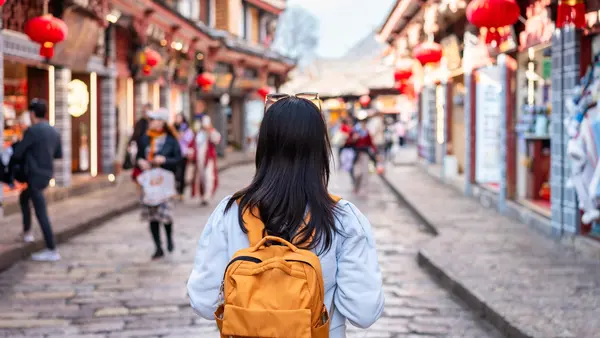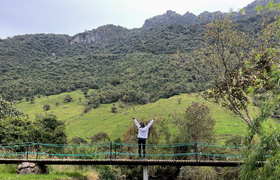
Authentic ways to connect with culture in China
Ancient relics, secret teahouses, bustling food quarters, and winding alleys — Chinese culture is best experienced up close, and these are the best ways to connect authentically with China’s living heritage
China is colossal, rich in history, and characterized as much by its ancient monuments and vast skylines as it is by its expansive frontiers and diverse communities. In a country so immense and fast-moving, it’s easy to get swept up in frantic itineraries that prioritize the volume of experiences over the quality of connection. But exploring a country of this scale is as much about marvelling at its grandeur as it is about making space for quiet, everyday moments.
Reframing travel in China means moving away from the mindset of a visitor and approaching instead with the curiosity of a student. On small-group tours led by expert Chief Experience Officers, G Adventures creates opportunities to discover the details beyond the landmarks: the magic of sipping tea in a hidden courtyard or watching a game of mahjong unfold in the shade of a city park. Here's how to get beneath the surface of China on your visit.
Walk the hutongs of Beijing
Historical alleyways nestled between traditional courtyard residences (siheyuan), the hutongs of Beijing form a fundamental part of the urban fabric of the city and a gateway into the heart of day-to-day life. Head over early in the morning and witness the awakening of the capital, an intimate encounter with the city in raw form before the crowds and tourists descend. Watch as the lanes slowly fill with stalls, bicycles, and the sounds of vendors preparing local favourites like steaming baozi (steamed buns) or crisp jianbing pancakes.
Together with the Forbidden City, these winding alleys are considered symbols of old Beijing, and they offer pockets in time that contrast starkly to the rapid modernization encountered in other parts of the country. In fact, many hutongs date from the 13th-century Yuan Dynasty and have been the subject of preservation programs after mass destruction once threatened to erase them.
Top tip: Round off your hutong visit with a traditional (and oh-so-scrumptious) Peking duck lunch. Depending on where you go, this meal can become a multi-course affair, complete with a tableside carving ritual. Don’t be surprised if it's the best Peking duck you’ve ever experienced — we still dream about ours to this day. It’s perfect fuel for an afternoon exploring the Forbidden City.

Experience it for yourself on: Highlights of China
Try street food in Xi’an
China is a place to embrace heat. Across the country, it’s not uncommon to see spice used in many dishes, from pepper flakes in stir-fried vegetables and Sichuan peppercorns in mapo tofu to fiery chilli oil used as a condiment. For the uninitiated, spicy Chinese food might seem daunting at first, but you’ll soon find the smoky blend of spice and garlic wafting from street food stalls too mouthwatering to resist.
One such place is the sensory-rich Muslim Quarter in Xi’an, a melting pot where Han Chinese and Hui Muslim cultures converge. An evening sampling local delicacies is a night well spent. Ready to dive into a portion of biangbiang noodles or spicy dumplings washed down with a cup of jewel-red pomegranate juice? Influences from the Silk Road infuse every dish, the flavours and techniques echoing across centuries of cultural exchange. Book a street food tour if you have allergies or other dietary requirements.
Top tip: Don’t leave Xi’an without visiting the Giant Wild Goose Pagoda, an ancient dwelling and sacred site for Buddhists. Take time to enjoy the serenity of this revered place, punctuated only by the soft calls of birds and the distant chanting of monks.

Experience it for yourself on: Ancient China
Watch pandas in Chengdu
We can’t fully prepare you for just how adorable giant pandas are. Somewhere between tumbling down slides and dozing belly up after a bamboo feast, China's pandas can and will steal your heart. The best place to admire these endearing creatures is at the Chengdu Research Base of Giant Panda Breeding, a government-funded nonprofit. Founded in 1987, this world-renowned conservation facility protects several rare species, including red pandas, which are known for their dark undersides and tear-marked faces.
Beyond the pandas, Chengdu’s parks are a window into the city’s unique rhythm and offer all kinds of wholesome leisure activities from teahouses and lush gardens to scenic mini hikes. If you’re seeking cultural experiences in China, head to People’s Park for a moment of reflection while locals play mahjong with friends or practice tai chi during the quiet hours. If you have time after, visit the bonsai garden or even take a glance at the age-old tradition of ear cleaning!
Top tip: Visit the pandas during cooler months, avoiding public holidays and weekends, and arrive as close to opening time as possible. This maximizes outdoor viewings, minimizes crowds, and enables you to see the pandas before they fall asleep for the afternoon. Booking in advance is essential, and you must present ID upon entry.

Experience it for yourself on: China's Hidden Highlights: Chengdu to Kunming
Hike a less-crowded part of the Great Wall
A jaunt along the Great Wall is a must during your visit to China, but which section to choose? Resist the temptation to follow the crowd to Badaling and opt for Jinshanling instead. While Badaling has a convenient location 61km (38 mi) north of Beijing, it's also the most famous and most visited section in the whole country, attracting huge crowds, especially during peak seasons and Chinese Golden Weeks. It's also heavily restored, which creates a bit of a disconnect from the original relic itself.
A little further away, 130km (80 mi) northeast of central Beijing, Jinshanling draws fewer tourists and is a great way to experience the Great Wall off the beaten path. Considered to be one of the most beautiful sections, it offers winding, panoramic views across rugged mountain landscapes that are simply awe-inspiring. It also combines both restored and original stonework, putting how it would have looked next to the remains today in seamless dialogue.
Top tip: Hikers and photography enthusiasts should trek from Jinshanling to the neighbouring section, Simatai West. It takes three to four hours and passes through a mixture of restored, unrestored, and wilder sections, with ample opportunity to experience (and photograph) the wall with no one else around.

Experience it for yourself on: Beijing to Kunming: Undiscovered China
Visit the Terracotta Army
Ride a smoother-than-air bullet train from Beijing to Xi'an and journey to the Terracotta Army, a mind-blowing collection of more than 8,000 life-size sculptures. Created to guard the tomb of China’s first emperor, Qin Shi Huang, the models depict the exact real-world soldiers and horses of his actual army. Each statue has been carefully rebuilt following the tragic destruction of the entire site, and it’s a humbling experience to walk around the pits and contemplate each face, a 3D portrait of a real person frozen in time.
Afterward, balance the grandeur of the site with something more intimate: a traditional local meal. Sit down to a bubbling hot pot and reflect on the strange beauty of the haunting mausoleum site. Sharing dishes with both locals and fellow travellers is the perfect way to deepen your cultural experience in Xi’an and root your visit in essential context.
Top tip: Visit during the early winter months to see some of the warriors in Pit 1 bathed in natural sunlight. Crowds are also greatly reduced during this season, offering the possibility to see the warriors (at least for some of the day) totally unobstructed. This time is ideal if you want to take photos or are uncomfortable in crowded spaces.

Experience it for yourself on: China & Vietnam: Beijing to Sapa Adventure
Sip tea in a Chengdu teahouse
No matter when you visit China, there’s nothing quite like the comfort of lifting a steaming cup of jasmine tea to your lips. The fragrance of the blend, the warmth, the centuries-old ritual — it’s something words can’t quite touch. In Chengdu, ancient teahouses are widespread and extremely popular, serving as a gateway to community and a window into tea culture in general. Chengdu’s ornate, bamboo-chaired teahouses have held multiple functions throughout time, from important social hubs and places of relaxation to gathering sites for business meetings, negotiations, lessons, and even disputes. To this day, some still host amateur Sichuan opera or storytelling, while others may show traditional folk arts. During your visit to Chengdu, take the opportunity to savour different blends across a selection of sites.
Top tip: Head to Heming Teahouse in People’s Park to experience authentic tea culture while relaxing under the trees or by the pond. It’s the largest and oldest in the park and has gathered some fame in recent years, so you might have to wait for a table.

Experience it for yourself on: China & Vietnam: Chengdu to Hanoi
Explore Yangshuo’s countryside by bike
Connect with China’s expansive spaces than by pedalling along the misty riversides of Yangshuo. Located in the Guangxi region, this resort town and county is known for its dramatic landscapes, with lush greenery and otherworldly karst mountains that stretch like stone sentinels into the distance. Ride past rice paddies and take in the slower, rural side of this magnificent country.
Alternatively, experience the scenery from the water with a cruise down the Li River. Sail through towering peaks, drift past bamboo groves, watch as fishers glide by on traditional rafts, and gaze on picturesque villages that look straight out of a painting. Whether on wheels or by boat, Yangshou’s countryside offers a serene and immersive voyage into China’s natural beauty, and it's a glimpse into day-to-day life away from the bullet trains and megacities.
Top tip: For an even more peaceful experience, book a ride on a traditional bamboo raft. These vessels are non-motorized and typically accommodate up to four people, offering a much slower, quieter way to appreciate the tranquility of the environment.
Experience it for yourself on: China Uncovered




